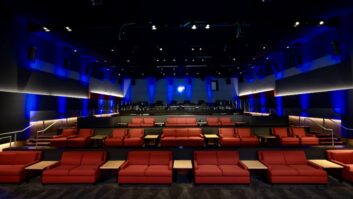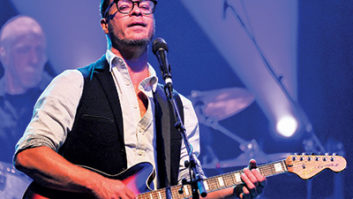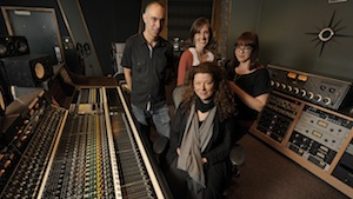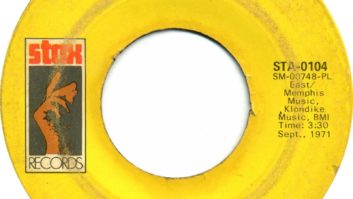The sound team at NBCUniversal StudioPost recently completed work on Unbroken, based on author Laura Hillenbrand’s 2010 best-selling biography of long-distance runner Louis Zamperini and his experiences during World War II. It opens nationwide on Christmas Day. Here, they share their experiences on working with director Angelina Jolie, keeping the sound authentic to the period, mixing in Dolby Atmos and much more.
On working with director Angelina Jolie:
“JT [re-recording mixer Jon Taylor] and I had worked with her before on Land of Blood and Honey,” says Becky Sullivan, co-supervising sound editor.
“On the first movie we did with her, it became very obvious that she’s not only so unbelievably intelligent, but grasps all of filmmaking,” says Taylor. “She loves sound.”
“I think, starting her career as an actress and evolving into a director, I think she is very in tune with when a performance is real, and what the emotion is, how it reads, and once it’s up on the screen, how is that emotion,” adds co-supervising sound editor Andrew DeCristafaro. “Is it reading as honest and real, just like the performance?
“She’s very in tune with that. She’s very hands-on. She’s delicate with you about how to do it, but she guides you in the right direction. She gave us a lot of freedom, but it was more about, do your thing but I want it to be real, I want it to be visceral.”
According to re-recording mixer Frank Montaño, “She’s very in tune with what the music’s doing, with the emotional side of everything; something that gives you a feeling, no matter how small or how big the sound is.”
On keeping the sound authentic to the period:
“The film is a true story—it’s not ‘based on’ or ‘loosely based on,’” says DeCristafaro. “They stay true to the book, and everything had to be authentic, yet still deliver the emotional excitement that you want in a film. But it’s not an overly designed film. I’m really proud of the work; I think it sounds great.”
He continues, “Usually we’re either in a big action film and it kind of stays in that mode, or we’re in a really quiet movie. This gave us a huge, broad band. So trying to be authentic to everything was one of the big challenges—making sure we had the right weapons, rate of fire for the weapons, caliber for the weapons, impacts, hits, punches, vehicles. [Jolie] didn’t want anything to be ‘Hollywood,’ but for it to totally make sense.”
“The first thing we did is look for a B-24 [plane], the Liberator,” Sullivan recalls. “Andrew and I found a foundation in Florida, the Collings Foundation; they have an authentic B-24. There were other B-24s in Texas and in other places, but they were all altered. This one was not altered, and we had to get that sound.
“It took me six months to follow the plane, but finally it was in Van Nuys [Van Nuys Airport, near Los Angeles] and we got to spend a day on it, which was an amazing, amazing day. I think we had eight or nine people [recording].”
“Everyone had multi-track recorders and mics, everyone’s holding up stuff. When we lined up everything, we had about 24, 32 tracks of audio,” reports DeCristafaro. “There was a point where we got it to fly overhead. We also had a B-17 with us that day. We were lying on the tarmac as it flew overhead; it was awesome.”
On recording ADR:
“There’s much ADR in this film,” says DeCristafaro. “Not because of performance, but for technical reasons. That is always the most difficult thing to sell, especially to such a great actress as Angelina Jolie is. And it was beautiful; it really worked, all the way through. All the actors were amazing. I’d say that ADR really tells you what kind of an actor you’ve got, and these actors came in and did amazing jobs.”
ADR was recorded over a period of months and at various locations, says Sullivan, and presented challenges both in terms of performances and technology. “Our lead actor, Jack [O’Connell], who plays Louis, is British, and has a thick British accent. Our lead actor who plays Phil [Domhnall Gleeson] is Irish, and has a thick Irish accent. Our lead who plays the Bird [Takamasa Ishihara, AKA Miyavi] is a rock star from Japan who has limited English. Thank goodness for subtitles and dialog coaches. We had Jack here, the dialog coach was in England, and I had her on an iPad on the stand talking to him, because she couldn’t be here—it was a lot of challenging things.”
She continues, “I looped Jack for days here, there and all over the world. We’d get a scene at a time. Everything on the airplane was looped, because of sound challenges. Just getting back to that place—it’s a dark, dark place. But Angie, she just says a few words to them, and they’re right there. She’s a formidable director. She would always steer them into exactly the right space.”
The production dialog from the life raft scenes was also largely unusable due to challenges at the location of the shoot. “We brought them into the stage. I cleared the floor off and laid them down—because I wanted them to feel like they were sitting down low—and I put a couch behind them and some seat cushions, so they could put their arms on it and feel like they were sitting in the raft. Then we turned all the lights off, and said, we’ve got to get you back there. I took all the water bottles off the stage, because we were trying to get the dry throats, and would have them breathe in and out a lot to get their throats dry, so as they progress on the raft, it gets drier and drier.”
Ultimately, she says, it all comes down to performance. “You’ve got to get it right, you’ve got to get it true. Especially on those rafts. We had a little library of mouth clicks and swallows that we would normally clean out, but for the ADR, Laura [Harris, dialogue editor] had this little library of mouth clicks, because it made it more real. We’d throw in that sound, and a swallowing sound, throughout the different lines, because it made it more real. It made it not sound like ADR, but dialog. And then JT was awesome with the mix. I’m very proud of it; those performances are spot on.”
“But the first thing Becky did,” says Taylor, “which I think was really smart, was to do an A/B test [of production dialog, Foley and effects versus looped dialog, Foley and effects] of what’s probably one of the most important sections of the raft scene, and played it for Angelina. It was an amazing difference. The key was getting the performances from the actors, and knowing how to record them and what’s comfortable. And it worked amazingly well; everybody was absolutely thrilled.”
The Unbroken post team included (clockwise from top) Jon Taylor, Andrew DeCristofaro, Becky Sullivan and Frank Montano.

On Alexandre Desplat’s score:
According to DeCristafaro, Unbroken started out with relatively little music. “As the pieces were put together, and as the film was cut closer to what the final was going to be, we started adding more and more,” he says.
“But it’s kind of two films, in a way. You start in the bomber, before he’s held captive, then, once he’s held captive, that’s another piece of the film. So the music totally changes. It’s very grand in the beginning, a more action-y, full score. Then, when he’s imprisoned, it becomes very psychological, much more internalized. But it ties the whole movie together. It’s not like you’re watching another movie—which was [Jolie’s] goal all along.”
On mixing in Dolby Atmos in the newly upgraded Hitchcock Theater:
The mix team completed the 5.1 and 7.1 mixes in Universal’s Dub 6 before moving to the Hitchcock Theater, where the studio’s engineering staff had just completed an upgrade enabling the stage to accommodate both Dolby Atmos and Auro-3D as well as IMAX production and playback. The upgrade involved the addition of 78 new speakers, including JBL 5674 series screen channels, AM7212 surrounds, and various models supporting output channels specific to the different platforms: AM7212 and AM7215 models for Atmos, AM7315 and AM7212 speakers for Auro, and AM7315 speakers for IMAX. The mix stage also incorporates Meyer Sound X-800 powered subwoofers and custom-designed surround subwoofers.
The Hitchcock Theater is also outfitted with a Harrison MPC4-D fully automated digital console that offers 40-bit floating point DSP processing, with 768 primary channel inputs, 1024 secondary inputs, 128 mix busses and 32 aux busses. It supports a total of 1344 inputs, 240 record channels and 800 payback channels. A Dolby DSS-200 screen server enables digital projection of the supported playback formats.
“Our engineering staff did a great job of learning what not to do from other experiences, from friends and colleagues at other places,” says DeCristafaro. “The Atmos sounds great; everyone did a great job. It’s dynamic, it’s subtle. In some of the body in the middle of the film there’s nowhere to hide, so you are literally there. Even in the 7.1, we made sure that’s it’s a really nice, discrete point source with the raft in the water, but it’s got a movement to it. It doesn’t just settle into this pocket that turns vanilla, it actually has movement in it. The film lends itself to these sequences. We have a little stretch of quiet, subtle, open ocean, then into a storm, then into a Japanese strafing attack on the raft, and some really cool opportunities, Atmos opportunities.”
Taylor enjoyed the opportunities afforded by mixing in Atmos. “Just to be able to open the room up, bigger than what we’re used to, was amazing. The whole opening was amazing, with the effects, and really being able to use the overheads,” he says. “But musically speaking, and with ambiance also, just being able to subtlely open the score up just a little more, let the strings just float a little more than you’re usually able to do in any other format, was just beautiful.”
“Very specific parts of the score were pulled out, not in a general sense,” stresses DeCristafaro. “We spoke early on about not crossing the line of gimmicky, and keeping it subtle—impactful, but not pulling you away from the story.”
“Not that we didn’t try things!” laughs Taylor. “We tried things that were on the edge of gimmicky, things that were just not for this film. It was really about authenticity.”






